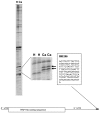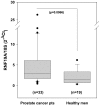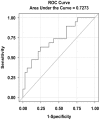Averaged differential expression for the discovery of biomarkers in the blood of patients with prostate cancer
- PMID: 22493721
- PMCID: PMC3321043
- DOI: 10.1371/journal.pone.0034875
Averaged differential expression for the discovery of biomarkers in the blood of patients with prostate cancer
Abstract
Background: The identification of a blood-based diagnostic marker is a goal in many areas of medicine, including the early diagnosis of prostate cancer. We describe the use of averaged differential display as an efficient mechanism for biomarker discovery in whole blood RNA. The process of averaging reduces the problem of clinical heterogeneity while simultaneously minimizing sample handling.
Methodology/principal findings: RNA was isolated from the blood of prostate cancer patients and healthy controls. Samples were pooled and subjected to the averaged differential display process. Transcripts present at different levels between patients and controls were purified and sequenced for identification. Transcript levels in the blood of prostate cancer patients and controls were verified by quantitative RT-PCR. Means were compared using a t-test and a receiver-operating curve was generated. The Ring finger protein 19A (RNF19A) transcript was identified as having higher levels in prostate cancer patients compared to healthy men through the averaged differential display process. Quantitative RT-PCR analysis confirmed a more than 2-fold higher level of RNF19A mRNA levels in the blood of patients with prostate cancer than in healthy controls (p = 0.0066). The accuracy of distinguishing cancer patients from healthy men using RNF19A mRNA levels in blood as determined by the area under the receiving operator curve was 0.727.
Conclusions/significance: Averaged differential display offers a simplified approach for the comprehensive screening of body fluids, such as blood, to identify biomarkers in patients with prostate cancer. Furthermore, this proof-of-concept study warrants further analysis of RNF19A as a clinically relevant biomarker for prostate cancer detection.
Conflict of interest statement
Figures



Similar articles
-
Molecular Diagnostic of Prostate Cancer From Body Fluids Using Methylation-Specific PCR (MS-PCR) Method.Clin Lab. 2016;62(6):1183-6. doi: 10.7754/clin.lab.2015.151019. Clin Lab. 2016. PMID: 27468582
-
Use of two gene panels for prostate cancer diagnosis and patient risk stratification.Tumour Biol. 2016 Aug;37(8):10115-22. doi: 10.1007/s13277-015-4619-0. Epub 2016 Jan 28. Tumour Biol. 2016. PMID: 26820133
-
Identification of prostate cancer mRNA markers by averaged differential expression and their detection in biopsies, blood, and urine.Proc Natl Acad Sci U S A. 2007 Feb 13;104(7):2343-8. doi: 10.1073/pnas.0610504104. Epub 2007 Feb 5. Proc Natl Acad Sci U S A. 2007. PMID: 17283334 Free PMC article.
-
New targets for therapy in prostate cancer: differential display code 3 (DD3(PCA3)), a highly prostate cancer-specific gene.Urology. 2003 Nov;62(5 Suppl 1):34-43. doi: 10.1016/s0090-4295(03)00759-3. Urology. 2003. PMID: 14607216 Review.
-
RNA biomarkers to facilitate the identification of aggressive prostate cancer.Mol Aspects Med. 2015 Nov;45:37-46. doi: 10.1016/j.mam.2015.05.003. Epub 2015 May 27. Mol Aspects Med. 2015. PMID: 26022941 Free PMC article. Review.
Cited by
-
RNF19A-mediated ubiquitination of BARD1 prevents BRCA1/BARD1-dependent homologous recombination.Nat Commun. 2021 Nov 17;12(1):6653. doi: 10.1038/s41467-021-27048-3. Nat Commun. 2021. PMID: 34789768 Free PMC article.
-
Identification of crucial genes and pathways associated with prostate cancer in multiple databases.J Int Med Res. 2021 Jun;49(6):3000605211016624. doi: 10.1177/03000605211016624. J Int Med Res. 2021. PMID: 34082608 Free PMC article.
-
The identification of gut neuroendocrine tumor disease by multiple synchronous transcript analysis in blood.PLoS One. 2013 May 15;8(5):e63364. doi: 10.1371/journal.pone.0063364. Print 2013. PLoS One. 2013. PMID: 23691035 Free PMC article.
-
Ring finger protein 19A is overexpressed in non-small cell lung cancer and mediates p53 ubiquitin-degradation to promote cancer growth.J Cell Mol Med. 2021 Aug;25(16):7796-7808. doi: 10.1111/jcmm.16674. Epub 2021 Jun 29. J Cell Mol Med. 2021. PMID: 34184814 Free PMC article.
-
Role of androgen receptor in progression of LNCaP prostate cancer cells from G1 to S phase.PLoS One. 2013;8(2):e56692. doi: 10.1371/journal.pone.0056692. Epub 2013 Feb 20. PLoS One. 2013. PMID: 23437213 Free PMC article.
References
-
- Catalona WJ, Smith DS. Cancer recurrence and survival rates after anatomic radical retropubic prostatectomy for prostate cancer: intermediate-term results. J Urol. 1998;160:2428–2434. - PubMed
-
- Walsh PC, Partin AW. Important Adv Oncol; 1994. Treatment of early stage prostate cancer: radical prostatectomy. pp. 211–223. - PubMed
-
- Shipley WU, Thames HD, Sandler HM, Hanks GE, Zietman AL, et al. Radiation therapy for clinically localized prostate cancer: a multi-institutional pooled analysis. JAMA. 1999;281:1598–1604. - PubMed
-
- Bill-Axelson A, Holmberg L, Ruutu M, Garmo H, Stark JR, et al. Radical prostatectomy versus watchful waiting in early prostate cancer. N Engl J Med. 2011;364:1708–1717. - PubMed
Publication types
MeSH terms
Substances
LinkOut - more resources
Full Text Sources
Medical

